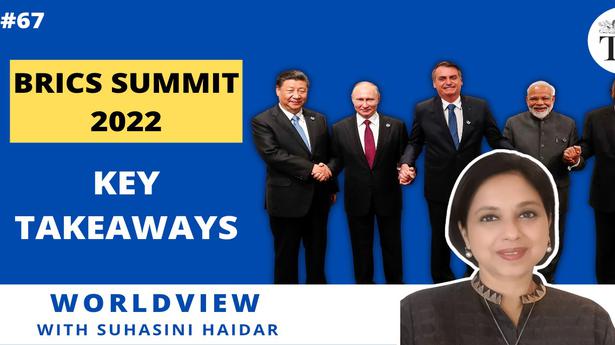
Worldview with Suhasini Haidar | What are the key takeaways from the 14th BRICS Summit?
The Hindu
In this episode of Worldview, we discuss whether BRICS would be an effective anti-thesis to the developed world’s most industrialised nations led by US and Europe at the G-7?
Is BRICS, a grouping of once emerging economies from Asia, Africa and South America an effective anti-thesis to the developed world’s most industrialised nations led by US and Europe at the G-7? More importantly, how does India navigate its role in the grouping, given BRICS’ clear criticism of the west’s economic domination of the world, the current standoff between Russia and the west, along with India’s problems with China?
Origin of the BRICS:
- Unlike other regional, economic and political groupings, the BRICS idea came not from its members, but from a paper by a Goldman Sachs economist in 2001- who suggested that instead of setting up the world’s then emerging economies as a separate group, that they be brought into an expanded G-7. In those days, Russia had just been taken into the G-7 to make it the G-8, but it was still an outlier. The paper made the case that by 2039- the four economies Russia, India, China and Brazil, would upend the global economic order and overtake G-7.
- In 2009, the leaders of the four countries met and formed BRIC, adding South Africa in 2010. Russia’s ties with the West had begun to unravel after the war with Georgia in 2008, and Russia was ousted from G-7 by 2014.
- Since then BRICS has met every year and set up several initiatives, defying all predictions that it would crumble given the downturn in the economies of all members, with the possible exception of China.
- BRICS may be disparate countries on four continents, but they together represent 27% of the world’s land mass, and 42% of the world’s population, 24% of global GDP, and 16% of Global trade, and produce 33% of the world’s food
What was the significance of the BRICS summit on June 23-24 this year?





















 Run 3 Space | Play Space Running Game
Run 3 Space | Play Space Running Game Traffic Jam 3D | Online Racing Game
Traffic Jam 3D | Online Racing Game Duck Hunt | Play Old Classic Game
Duck Hunt | Play Old Classic Game











